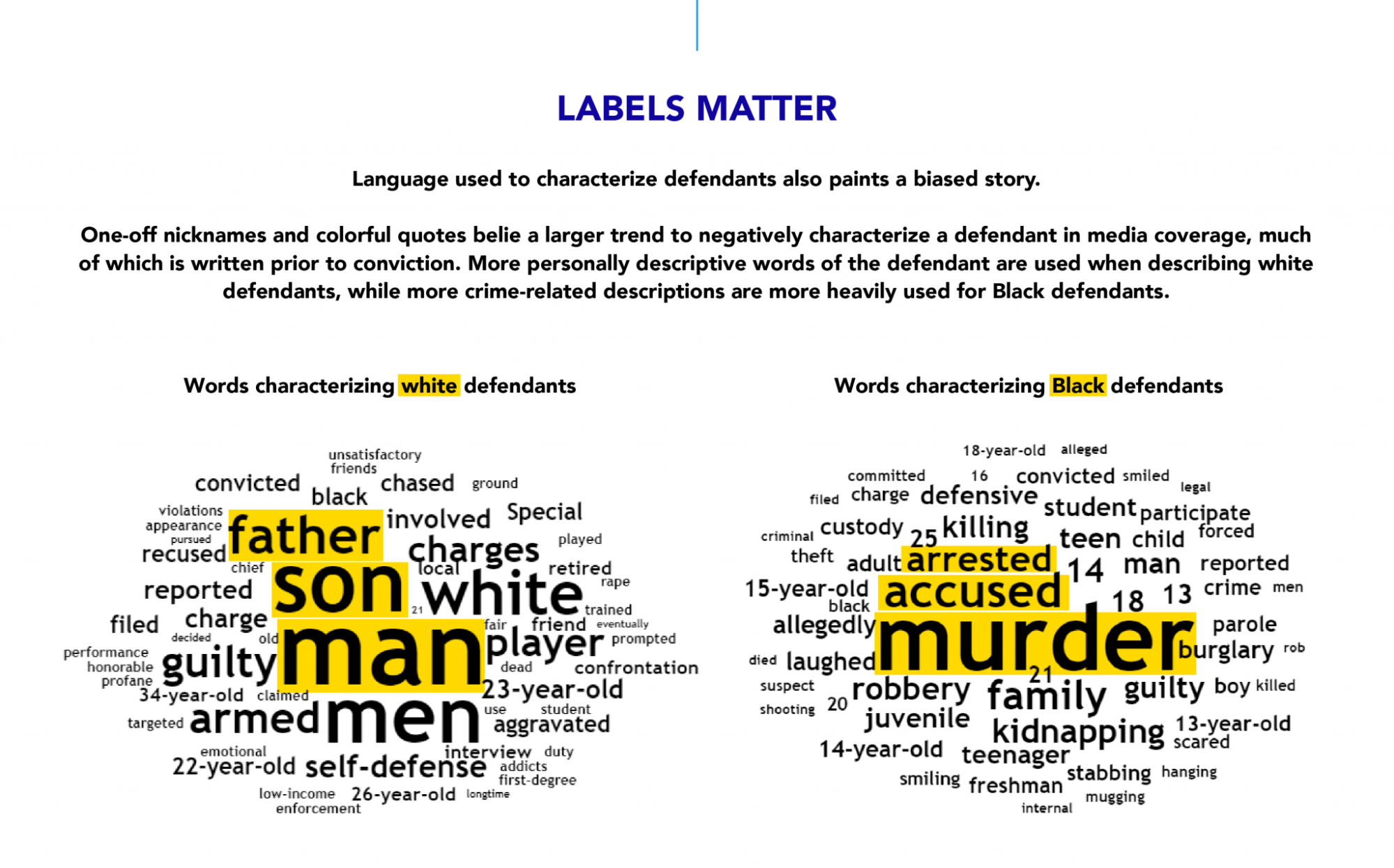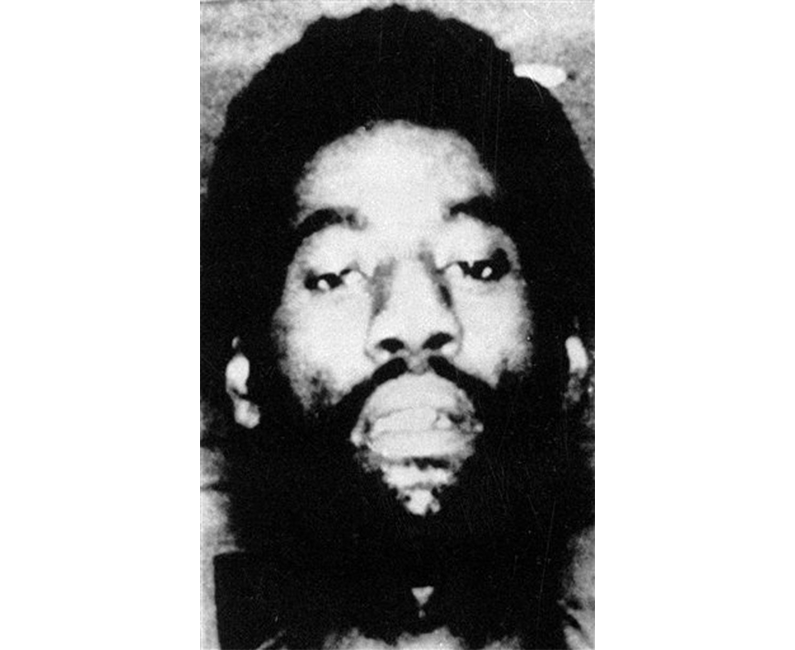7.4 The Role of Mass Media in Crime and Punishment
Although media involvement is not an official step in the criminal justice process, it is a factor in how people are viewed and treated by those within the system and those in society, so let’s look at the role that mass media can play in perpetuating injustices in our system. Media representations and discussions of crime can provide viewers with inaccurate images of crime and the criminal legal system. Typically, studies report that the media distorts the crime picture by focusing on certain crimes, overemphasizing how often crime occurs, and failing to provide accurate or thorough information about criminal incidents. Growing evidence suggests that news media coverage of people of color helps fuel racial prejudice and stereotypes. By presenting people of color in a negative light, the media may reinforce the prejudice that individuals already have or even increase their prejudice (Larson, 2005).
Dixon (2018) examined representations of families by race in national and local news on television, in print, and online from 2015 to 2016. They found that news and opinion media do perpetuate inaccurate representations of Black families across several different areas of coverage. Dixon’s findings support prior research that suggested that the news media in the past have overrepresented poor people as being Black. Dixon (2018) found that the media overrepresented Black family poverty while white family poverty is underrepresented. They also found news and opinion media were more likely to identify Black fathers as uninvolved and generally not present for their families. However, evidence shows that Black fathers are more involved in parenting than white fathers, both when comparing Black and white fathers who live with their children and when comparing Black and white fathers who live separately from their children (Dixon, 2018). Finally, about criminal justice, Black men are overrepresented as criminals. Stereotypes perpetuated by the news media ultimately inform public policy, like making it harder to access resources, requiring drug testing, and limiting welfare (Jan 2017). White men benefited from the anti-poverty programs in the 1920s and 1930s but were portrayed as having “run into hard luck” and needing “help them through the tough times” (Jan, 2017).
Other studies have found the news media use pictures of Black people far more often than those of white people in stories about poverty. Global Strategy Group (GSG) recently reviewed the media coverage of 10 criminal cases to see how the five white defendants were presented to the public compared to the five Black defendants (GSG, 2021). In news stories about arrests, photos are commonly shown of the defendants. For those who are Black, their mugshot was used as the photo 45 percent of the time compared to only 9 percent of the time for white defendants. Conversely, 16 percent of the time, white defendants were displayed using a photo of them in a suit compared to only 6 percent of the time for Black defendants. Also, 8 percent of the time, Black defendants were shown wearing their jail jumpsuits, which never occurred for white defendants. When the victim was white, 79 percent of the time, they were shown in a photo with family or friends. This was the case only 21 percent of the time when the victim was Black. Consider how this subliminal messaging affects the way viewers take in and think of the people involved in the news story. How might using these photos contribute to negative racial stereotypes of people who have committed crimes?
GSG explains this imaging reinforces, “existing tendencies to dehumanize Black pain and suffering and, by the same token, put a face to white victims” (GSG, 2021). The words used to describe defendants also support racist tropes. For example, white defendants are referred to as “father” or “son” and are 50 percent more likely to be called by their names, whereas Black defendants are more often referred to by the crime and penalty as the “accused,” the “arrested,” and with the word “murder” (GSG, 2021). Finally, when others are interviewed to offer comments about the defendant for a news article, friends and family are twice as likely to be interviewed on behalf of white defendants, whereas judges and lawyers are interviewed for Black defendants, “which presents the readers with a less humanizing account of Black defendants” (GSG, 2021). If you want to learn more, see “Report Documents Racial Bias in Coverage of Crime by Media” in the Chapter Resources.
Time and Newsweek have also portrayed Black people in almost two-thirds of their stories on poverty, even though only about 17 percent of people living below the poverty line in 2022 were Black. In the magazine stories, only 12 percent of Black people had a job, even though at that time more than 40 percent of poor Black people were working at the time the stories were written (Shrider, 2023). In a study of Chicago television stations, Black people arrested for violent crimes were twice as likely as white people arrested for violent crimes to be shown being handcuffed or held by police (Entman and Rojecki, 2001). Many other studies find that newspaper and television stories about crime and drugs feature higher proportions of Black people as offenders than is true in arrest statistics (Lundman, 2003; Surette, 2011).
Studies like these show that the news media “convey the message that [B]lack people are violent, lazy, and less civic-minded” (Jackson, 1997:A27). A recent study from Oregon State University (OSU) finds that while more formal clothing may deflect certain racially biased assumptions, many people still hold negative stereotypes about Black men based on what they’re wearing. People in the study judged the Black models to be harder working and more intelligent when they were wearing formal attire than when they wore sweatpants. “The main message is that clothing leads to snap judgments, to stereotyping,” said Regan A. R. Gurung, a psychology researcher at OSU’s College of Liberal Arts (Gurung et al., 2021).

Does this stereotypical media coverage affect public views about racial and ethnic groups? The answer appears to be yes, as research finds a link between the proportion of Black offenders in television news stories and crime shows and the fear of crime experienced by white viewers of these programs: the higher the proportion of Black offenders, the greater the fear of crime the viewers expressed (Eschholz, 2002). According to the Director of the Equal Justice Initiative,
Racially biased media coverage has been a substantial factor contributing to unreliable and unjust outcomes in the criminal legal system. News media have often reinforced a presumption of guilt and dangerousness assigned to Black people when reporting on crime while devaluing the lives of Black people and the harm they suffer when victimized. American media can and should do better in eliminating racially biased coverage (Stevenson, 2021).


If media coverage of crime-related stories can shape public opinion and reinforce prejudices, it can just as easily influence related voting decisions, determine program funding, and drive policy changes. See the Learn More section below for more on the connection between politics, media, and policy.
Learn More: Willie Horton and the Politics of Fear
https://www.youtube.com/watch?v=AUxAMG8UqIw
The case of Willie Horton is foundational when discussing how media representation can influence policy changes. Mr. Bush’s run for the presidency in 1988 was racially charged and focused on a get-tough-on-crime approach. In this video clip, The New York Times profiles how an attack ad made by George Bush’s supporters for his 1988 presidential campaign stoked racial fears through a narrative about Willie Horton, a Black man. Willie was away on a weekend pass from prison, where he was serving a life term for first-degree murder and had recommitted a violent crime. Willie kidnapped a white couple and then raped the woman and stabbed the man; his story was the feature of a key campaign commercial on behalf of the 1988 presidential campaign of then Vice President George H.W. Bush. Horton’s case shaped the politics of crime and punishment for the next three decades. Prejudicial media depictions of racial matters do indeed have prejudicial effects. Many Black people were impacted by this campaign. “The campaign encouraged more race-based politics and put Democrats on the defensive, forcing them to prove themselves on crime at the expense of a generation of Black men and women who were locked up under tougher sentencing laws championed by President Bill Clinton, among others” (Baker, 2018). President Barack Obama was trying to forge a bipartisan coalition to overhaul the criminal justice system and have more just sentencing laws, but some lawmakers worried it could be political suicide (Baker, 2018).

Check Your Knowledge
Licenses and Attributions for The Role of Mass Media in Crime and Punishment
Open Content, Original
“The Role of Mass Media in Crime and Punishment” is adapted from “Race and Ethnicity” by Anonymous, Sociology: Understanding and Changing the Social World (Barkan), which is licensed under CC BY-NC-SA 4.0. Modifications by Shanell Sanchez, Catherine Venegas-Garcia, and Taryn VanderPyl, revised by Jessica René Peterson, licensed under CC BY-NC-SA 4.0, include revising for clarity, recency, and brevity.
All Rights Reserved Content
Figure 7.5. Image from “Study finds clothing-based racist stereotypes persist against Black men” by Regan A.R. Gurung, © Oregon State University, is included under fair use.
Figure 7.6. “A Picture is Worth a Thousand Words” from “Innocent Until Proven Guilty” © Global Strategy Group, Equal Justice Initiative is all rights reserved, included with permission.
Figure 7.7. “Labels Matter” from “Innocent Until Proven Guilty” © Global Strategy Group, Equal Justice Initiative is all rights reserved, included with permission.
Figure 7.8. “How Bush’s 1988 Campaign Ushered in a New Era of Racial Politics | NYT News” by The New York Times is licensed under the Standard YouTube License.
Figure 7.9. Image from “Willie Horton Revisited” via the Marshall Project is included under fair use.
a group of people living in a defined geographic area that has a common culture
an individual attitude based on inflexible and irrational generalizations about a group of people and literally means “judging before.”
widely held beliefs or assumptions about a group of people based on perceived characteristics.
a category of people grouped because they share inherited physical characteristics that are identifiable, such as skin color, hair texture, facial features, and stature
automatic and exaggerated mental pictures that we hold about all members of a particular racial group.

